Louisiana Duck
10 Friday May 2024
Posted in What's For Dinner?
10 Friday May 2024
Posted in What's For Dinner?
21 Sunday Apr 2024
Posted in Beef, Buy Idaho, Buy Local, Cooking Classes, What's For Dinner?

Recently, 20 April, while at the BFM (Boise Farmers Market) I was asked by a local Chef why I prefer locally produced farm raised over comercially raised beef. And I suppose he meant pork and chicken too, over comercially raised. As most of you can surmise, I am adament about supporting local farmers and ranchers. That just might be my main reason. But let’s take a look.
The main differences between locally farm-raised and commercially-raised beef often lie in several factors including farming practices, scale of production, animal welfare standards, environmental impact, and often, the flavor and quality of the meat. Here’s a breakdown:
19 Friday Apr 2024
Posted in 5-Stars, Baking, Baking Sourdough, Beef, Boise Farmers Market, Bread, Breakfast, Brunch with Robin, Buy Idaho, Buy Local, challah, Cooking Oils, Cooking Styles, Dinner At The Captains Shack, Dinner With Robin, Food, Food - Jewish, Food Photos, Food Photos 60mm, French Foods, Garlic, Idaho Beef, Idaho Potatoes, Jewish Food, Local Farmers Markets, Local Harvests, Local Markets, Malheur River Meats, Mushrooms, Photos, Photos By: Bob Young, Potatoes, Recipe: Bob and Robin Young, Recipes, Recipes - Dinner, Sourdough, What's For Dinner?

I have received many requests for my recipes for CS Bread Braid (Challah) and CS Pot Roast. (https://www.rockinrs.com/CS-Bread-Braid.pdf and https://www.rockinrs.com/CS-Pot-Roast.pdf) The bread braid I added a little sourdough starter, but you don’t have to0, just add the amount of starter you would as water to the water amount in the recipe. But we liked the slight tinge of sourdough in the breade. And to the pot roast I added some button mushrooms quartered. You can use any mushrooms you want.These recipes were fun to develop and are very good, IMNSHO (In My Not So Humble Opinion).If you try them, let us know what you think, or what you changed. And it is perfectly OK to say that you didn’t like it, just tell my why. Here are the photos of the final products.
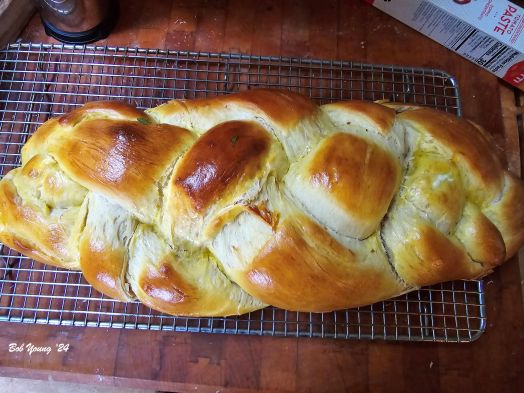

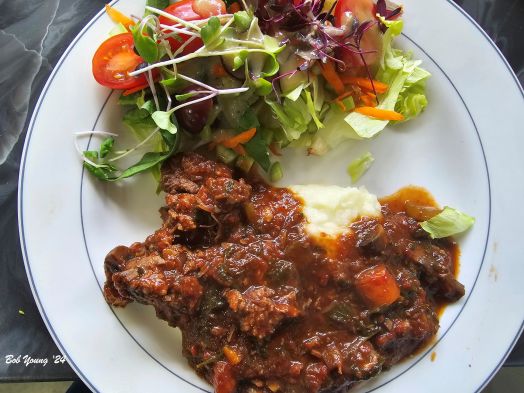
12 Friday Apr 2024
Posted in 5-Stars, Beef, Boise Restaurants, Ceviche, Classic Cuisines, Classic Sauces, Classics, Cooking Styles, Crab, Crab Cakes, Crème fraîche, Dinner at Coa Del-Mar, Food - Mexican, Food of Central America, Food Photos, Lobster, Main Dish, Mussels, New Restaurant Trial, Paella, Photos By: Bob Young, Restaurant Reviews, Rice, Scallops, Sea Scallops, Seafood, Shrimp, Special Events, What's For Dinner?, Wine and Food
Tags

It isn’t often that I write about a new restaurant and the By Invite Only dinner – pre opening – to “show off” their menu. But Coa Del-Mar, 2121 E Riverside Dr, Eagle, Idaho is one that I feel compelled to write about. It is well worth it. From their website, “… The nearly 10,000-square-foot restaurant includes a large patio that overlooks a pond.The restaurant will welcome customers on Monday, April 15. It has started to accept reservations on the Resy platform… The Latin and seafood-inspired restaurant will share similarities to both Barbacoa and co-owner Nikolai Castoro’s other restaurant in downtown Boise Coa De Jima. We’re going to bring hot rocks and icetinis and steak options, but the focus is on ceviches and fish options. We’re working to get seafood flown in fresh daily from Hawaii…In addition to its stunning artwork, Coa Del Mar boasts an impressive menu curated by Chef Enrique Martinez, featuring fresh seafood flown in daily and innovative takes on Latin-inspired dishes. From signature ceviches to Barbacoa’s famous “hot rock steak,” there’s something to delight every palate.”
It is large, spacy and can be rather loud due to the crowds of people. The art in the restaurant is all by local artists and it is beautiful. Prices are definitely high end but definitely worth it, and it would be a perfect place for that special dinner, for that special event, for that special person. Here are some photos of the restaurant. Thank you Joe Levitch for letting me join you for this event. I greatly appreciate it.

When you enter the restaurant, this is the artwork that greets you, less Joe Levitch.

The main dining room will keep you in awe with this beautiful Chihuly style glass work. It is huge and beautiful. That’s the inside. Now for some of the food and how each plate is presented.
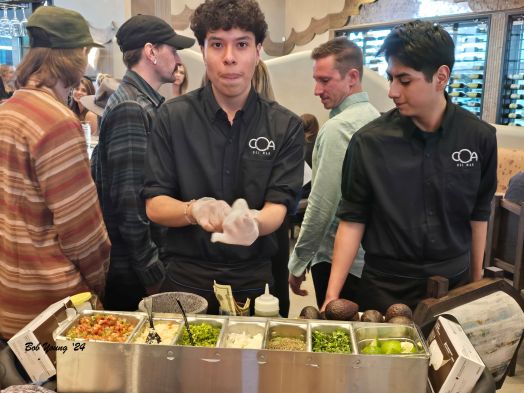
Making guacamole at your table.

Fresh made guacamole

The Beef Taco plate is beautiful and the meat is extremely tender and well prepared.

The Seafood Platter has lobster, scallops and shrimp on a Truffle Whipped Potato bed. Delicious! Some of the other entrees follow.
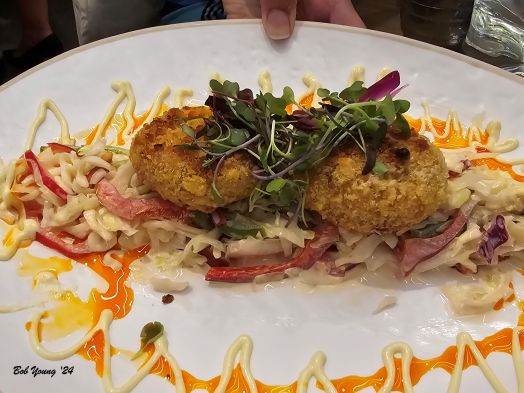
The folks sitting at the next table, were kind enough to let me photograph their dinners. These are Crab Cakes and they look delicious and not over stuffed with filler.
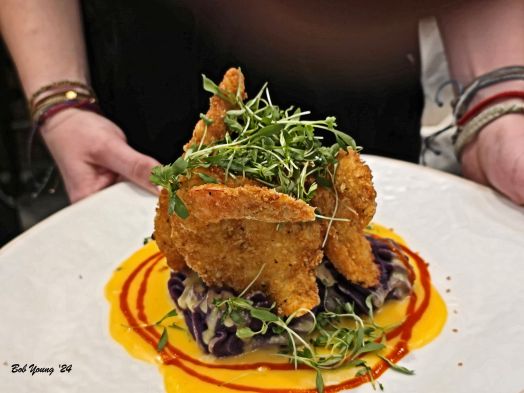
Coconut Shrimp
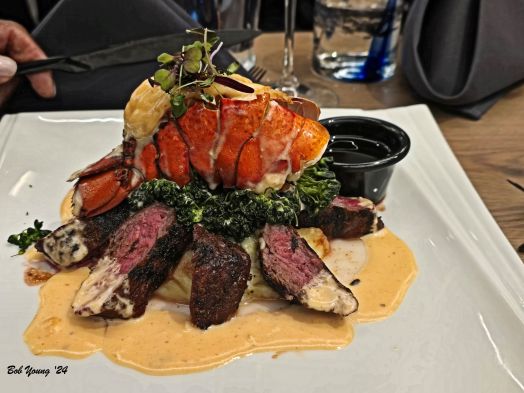
Lobster and Mussels
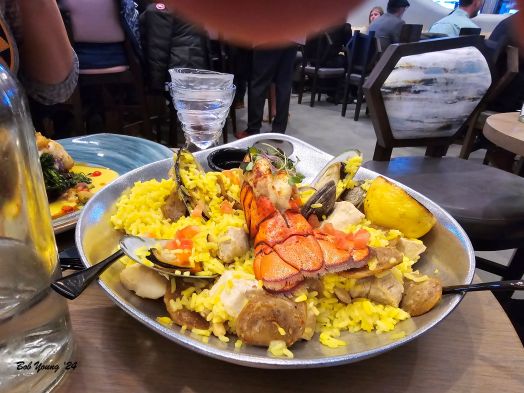
Seafood Paella

Key Lime Dessert

Creme Brule
So there you have a small sample of the dishes they offer. They are delicious. I hope if you are in the area, you call for reservations starting Monday April 15. You may not get a seat if you don’t call. There is a complete wine and liquor menu.
04 Thursday Apr 2024
Posted in 5-Stars, Aleppo pepper, Android Photos, Braising, Buy Idaho, Buy Local, Cabbage, Captain's Shack, Carrots, Classic Sauces, Comfort Food, Cooking Styles, Dinner At The Captains Shack, Food Photos, Food Prep, Heirloom Carrots, Herbs and Spices, Homemade Sauce, Housemade Sauces, Idaho Greens, Idaho Pork, Idaho Vegetables, Local Markets, Malheur River Meats, Photos, Photos By: Bob Young, Pork, Pork Tenderloin, Recipe By: Bob Young, Recipe By: Captain's Shack, Recipes - Dinner, tarragon, What's For Dinner?
Tags
Aleppo pepper, food, parsnips, pork, pork tenderloin, recipes, red cabbage

I do like pork! But I really need to change my preparation of the meat. If not the preparation, then the plating of it. What to serve with it? Sauerkraut is a pretty standard plating. But I wanted to change that, And o I came up with this. I used red cabbage, snow peas and carrot rounds, to sweeten it a little, and a little balsamic glaze to soften the cabbage flavor. I brazed it with just a little Aleppo pepper. The combination worked well and folks enjoyed it. Then I took parsnips and chunk diced them and braised them also.
The pork. Braised it over medium heat so not to burn it. Initially and before cooking I used our Pork Rub, (https://www.rockinrs.com/CS-Pork-Rub.pdf) all over the tenderloin and did not “skimp” on the amount. Then pat it into the meat and let it sit for about 30 minutes. The 2020 Parma Ridge Winery Boys Blend was superb with this dinner!
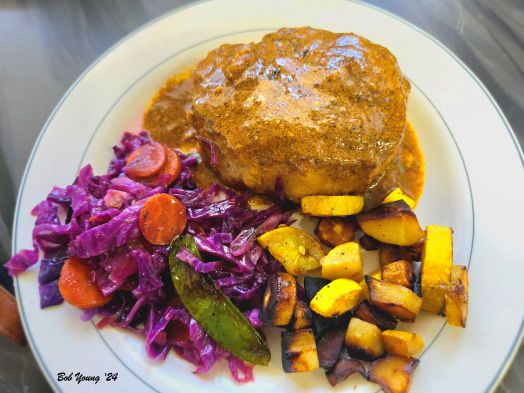
After braising the pork, I removed them from the heat and deglazed the pan (cast-iron skillet) with about 2 ounces of Tarragon Vinegar that we made a while back.Then a little butter in the drippings and some flour. Brought the roux together and added whole milk and about 2 T of Plochman’s mustard and stirred to combine and thicken. I then returned the tenderloin to the pan and spooned some of the sauce over it. After plating, I added a little more if it was needed. Everyone seemed to enjoy it – there is none left!
27 Wednesday Mar 2024
Posted in 5-Stars, Aleppo pepper, Baking, Buy Idaho, Buy Local, Carrots, Classics, Cooking Styles, Corn, Dinner At The Captains Shack, Dinner With Friends, Dinner With Robin, Ethnic Foods, Food - Make Your Own Meals, Food Photos, Garlic, Green Peas, Herbs, Herbs and Spices, History of Food, Idaho Lamb, Idaho Potatoes, Idaho's Bounty, Photos, Photos By: Bob Young, Potatoes, Recipe: Bob and Robin Young, Recipes - Dinner, Shepherd's Pie, Support Local Businesses, What's For Dinner?, Wines - Idaho
Tags
beef, cooking, Cottage Pie, recipes, shepards pie, Shepherd's Pie

I love a good Shepard’s (Shepherd’s) Pie! Much better than a Cottage Pie. Maybe that’s because I do like good lamb. And as a side point, lamb is one year old or younger, while mutton is older than a year, just in case you were wondering. But also, it intrigues me as to the origin of these dishes. I always thought it originated in the Basque country of Spain. But after researching for this article, I am wrong!
Shepherd’s Pie: This dish is believed to have originated in Scotland or northern England (Ireland) during the late 1700s to early 1800s. It was initially made with leftover roasted lamb or mutton, and the term “shepherd” in its name reflects the traditional use of lamb meat.
Cottage Pie is thought to have originated in England, particularly in the Midlands or northern regions, around the same time period as shepherd’s pie. It traditionally uses minced beef, and the term “cottage” likely refers to the modest dwellings of the rural working class, who would have commonly prepared this dish. The cottage pie was the precursor to shepherd’s pie, which was coined in the middle of the 19th century. For a while it was used interchangeably with cottage pie. However, as time went on, a distinction was made: shepherd’s pie referred to a dish made with lamb (because sheep are tended to by shepherds!), and cottage pie referred to a dish made with beef.

This is a Shepherd’s Pie that I made this past week. And I think it was really good. Good robust herb and vegetable flavors. And the ground lamb was awesome with no “wild” taste that you can get with mutton. And it was from a very local farmer. Meadowlark Farms in Nampa, Idaho to be exact. The crust was a combination of Russet (Idaho) potato and Red Potato. I did not have and Harvest Gold potatoes so I made my own! The browning on the top was from a combination of the potatoes and Parmesan cheese. So, if you are interested, here is the recipe I came up with. Feel free to try it. Just let me know how it came out and how much you loved it! https://www.rockinrs.com/CS-Shepards-Pie.pdf
08 Friday Mar 2024

The flowers here are some I bought Robin (my wife) a few days ago. They are springy, and we all know we can’t wait until Spring! I hate to throw away food with a passion. And if there is anything Robin has taught me over the past 40 years, is to use the leftovers, She was a magician with les restes, leftovers. So, a week ago I made a Tarragon Roasted Chicken (https://www.rockinrs.com/CS-Tarragon-Roasted-Chicken.pdf) that was awesome. We had some left over, so I thought about what to make. How about a Chicken Salad? And I’m glad I did. It was differently good with the addition of the tarragon and the cream sauce that went with it. Add un-peeled shredded carrot, diced celery, a little mayo and serve over chopped iceberg lettuce.
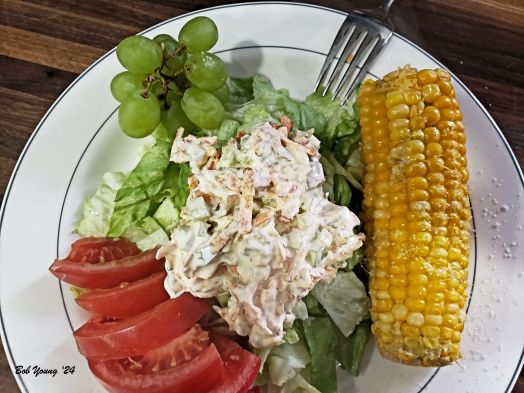
To the plate add some sliced tomato, corn on the cob and grapes and a wonderful dinner. Well, it’s almost Spring. Why not rush the season? I’m all for that! Voila!
01 Friday Mar 2024
Posted in 5-Stars, BBQ Sauce, Buy Local, Chicken, Classic Cuisines, Classic Sauces, Cooking Styles, Cream Sauces, Dinner At The Captains Shack, Food Prep, Garlic, Housemade Sauces, Idaho Chicken, Main Dish, Mushrooms, Mushrooms - Local, Photos, Photos By: Bob Young, Recipe By: Captain's Shack, Recipe by: Robin and Bob Young, Recipes, Recipes - Dinner, What's For Dinner?, Wines - Idaho

About a week ago while watching the Today Show, they made a spatchcocked chicken dish with tarragon. Spatchcocking is defined as a chicken or other type of bird that has been cut open down the backbone from tail to neck, pressed flat, and cooked, either in the oven, stove top or grilled. An interesting process that takes some skill, either by kitchen shears or a chef’s knife. So I took their process and recipe and altered it to our liking. I added some sliced button mushrooms and a little more wine. I also used Celtic sea salt and fresh ground Tellicherry black pepper. Here is our recipe: https://www.rockinrs.com/CS-Tarragon-Roasted-Chicken.pdf.
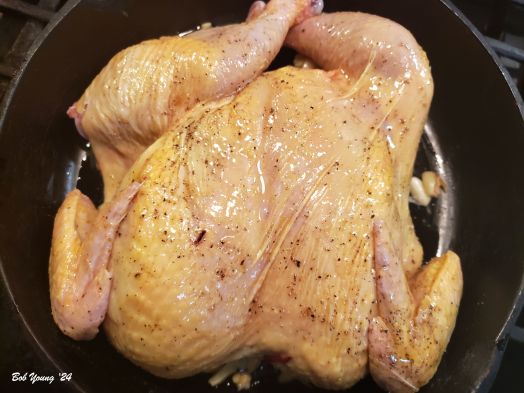
The chicken has been spatchcocked and it is in a large (12″), deep (2″) cast-iron skillet. It has been salted and peppered. The garlic is placed under the chicken.
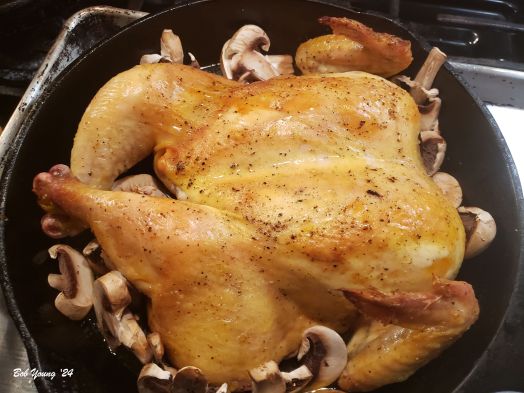
After cooking in the oven for 30 minutes at 450 degrees F and the skin is browned – I should have added about another 10 minutes – add the sliced mushrooms and a liberal amount of white wine.
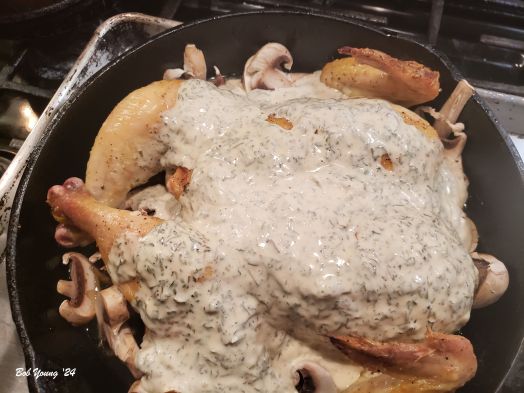
Then pour the heavy cream, chopped fresh tarragon leaves and Dijon mustard mixture all over the bird. Reduce the heat to 325 degrees Ft and cook for another 30-40 minutes.

After all that work, just follow the recipe, plate it up with some corn on the cob, pour a glass of good chardonnay and sit down, relax and have a delicious meal. As a note, 1 bulb of garlic sounds like a lot, but it will cook down, become sweet and delicious.

The other product that I have working on for the past several months, is BBQ Sauce. And I think we are there with this one. https://www.rockinrs.com/CS-BBQ-Sauce.pdf It is a mix of St Louis Style and Texas Style. Can be spicy if you want, just add more Aleppo Pepper. And there is a sweetness to it that is not over powering. The longer you keep it refrigerated, up to 6 months, the better it gets. And probably the strangest thing in it is Pomegranate Molasses. Not much because it can be powerful, but enough so you sayu, “What is that?”
Hope you have enjoyed these recipes and give them a try. Let us know what you think. Chau!
26 Friday Jan 2024
Posted in Captain's Shack, Food, Food Prep, What's For Dinner?
Tags

I keep getting questions about what are the differences between sauteing braising. It’s not that they are difficult to do, just different techniques and different foods for different cooking styles. Here3 is some information that I found that maybe, I hope, answer your questions.
Difference between Sautéing and Braising
Sautéing and braising are two different cooking methods. Sautéing involves cooking food quickly in a small amount of oil or fat over high heat. On the other hand, braising involves cooking food slowly in a covered pot with some liquid. Sautéing is used for cooking small pieces of food, while braising is ideal for tougher cuts of meat or root vegetables.
Sautéing and braising are two distinct cooking techniques with different purposes and methods. Here’s a brief explanation of each:
Sautéing:
Purpose: Sautéing is a quick cooking method used to cook small, bite-sized pieces of food over high heat.
Method: Food is typically cooked in a shallow pan with a small amount of oil or fat. The high heat quickly browns the exterior of the food while maintaining its internal moisture.
Examples: Sautéing is commonly used for vegetables, meat, or seafood. It’s ideal for cooking foods that don’t require a long cooking time.
Braising:
Purpose: Braising is a slow cooking method used for tougher cuts of meat to tenderize them and develop rich flavors.
Method: Food is first browned in a pan, similar to sauteing, and then it’s transferred to a pot with liquid (such as broth or wine). The pot is covered, and the food is cooked at a lower temperature for an extended period, allowing it to become tender.
Examples: Braising is often used for meats like beef brisket, lamb shanks, or pork shoulder. It’s suitable for cuts that require longer cooking times to break down collagen and connective tissues.
In summary, sautéing is a quick, high-heat cooking method suitable for smaller pieces of food, while braising is a slower method that involves browning and then simmering food in liquid, commonly used for tougher cuts of meat.
26 Friday Jan 2024
Posted in 5-Stars, Classic Herb Blends, Classic Sauces, Cooking Styles, Cream Sauces, Dinner At The Captains Shack, Food - Make Your Own Meals, Food Photos, History of Food, Homemade Sauce, Housemade Sauces, Italian Food, Passata, Pasta, Photos, Photos By: Bob Young, Recipe By: Captain's Shack, Recipes - Italian, Sauces, Scallops, Seafood, Shrimp, What's For Dinner?, Zucchini
Tags

I have been wanting to try this pasta for quite a while now and finally got up the nerve to try and make some. I think it came out very well. Originally, the sauce does not include any vegetables or protein. I changed that and used some large dice zucchini, shrimp, scallops and quartered crimini mushrooms. I like those additional items as it gives the pasta a good texture and mouth feel. Vodka Sauce is a popular Italian-American pasta sauce known for its rich and creamy texture. The exact origins of vodka sauce are unclear. One popular belief is that vodka sauce originated in Italian-American restaurants in the United States during the mid-20th century, more than likely in the 1970’s. Vodka was added to tomato sauce as a way to enhance the flavors of the ingredients. Vodka is thought to interact with the fat in the cream and the acid in the tomatoes, creating a smooth and balanced sauce. Here is a link to the recipe. Enjoy. https://www.rockinrs.com/CS-Penne-Pasta.pdf